Stromanthe Triostar is an outstandingly beautiful plant with vibrant leaf colorations. With good care this plant will provide a stunning living focal point in your home for years.
The long narrow textured leaves of the triostar stromanthe plant has interesting variegations in green, pink and white. Its a cheerful and exciting color combination.
Stromanthe triostar plants have Tri color foliage quite similar to the cultivar Calathea White Fusion.
Plant enthusiasts and even plant shops sometimes call it the Calathea triostar. That is technically incorrect.
The Scientific name for the triostar plant is Stromanthe sanguinea (recently changed to S Thalia).
Just look for some version of the triostar name and the dramatic leaves.
Breathe easy. Prayer Plants are air filtering plants that also inhale Co2 and exhale O2. And they are pet safe.
Put these beauties anywhere. Enjoy the beautiful foliage without concern for your kids or pets.
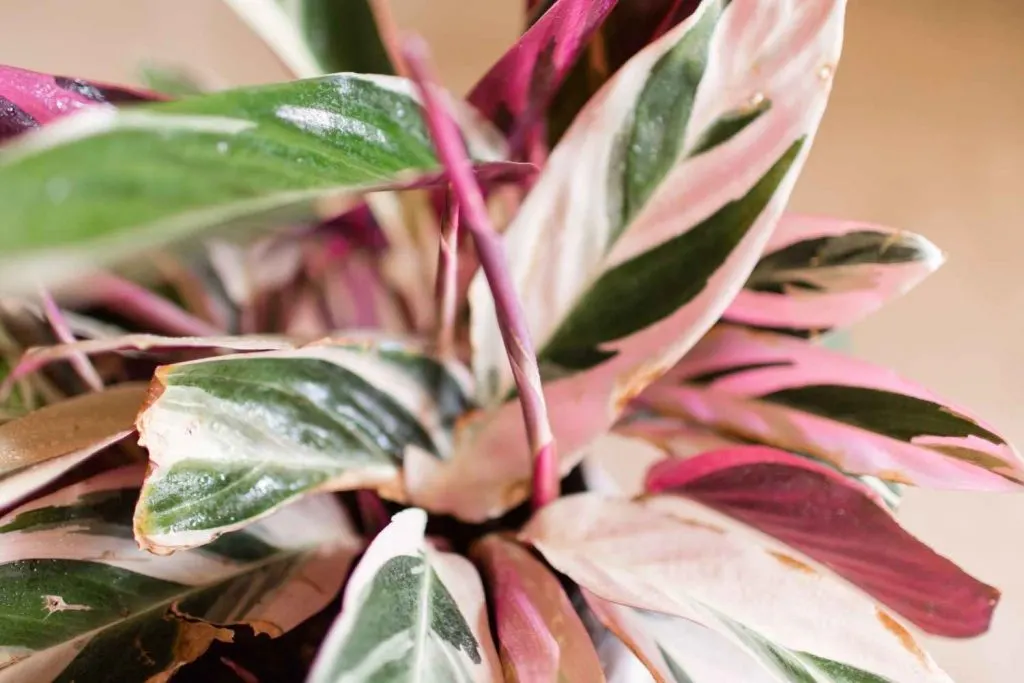
Tristar Plant Profile:
This prayer plant is in the plant family Marantaceae Stromanthes, calatheas, marantas and Ctenanthe plants are all prayer plants.
Like other “living plants”. Healthy Triostar plant leaves open in the light and close up after dark.
All through the day you may notice the leaves adjusting their position to catch the light.
Triostars are native to the Brazilian rainforests. They grow terrestrially in the dappled light under trees.
They can grow outdoors year round in any sub tropical Climate zone 9 to 11.
Bring it indoors If the temperature drops below 50 degrees F. You can also grow this plant as an annual if you wish.
It may flower outdoors in good conditions. But you will rarely see the small and rather insignificant flowers if grown indoors.
The foliage is so dramatic you won’t miss the flowers.
Shop Stromanthe Trio Star on Etsy:
These plants are usually easy to find in your local plant shops or garden nurseries. However, Etsy also has some very well reviewed plant shops that can safely ship them and any needed supplies to you.
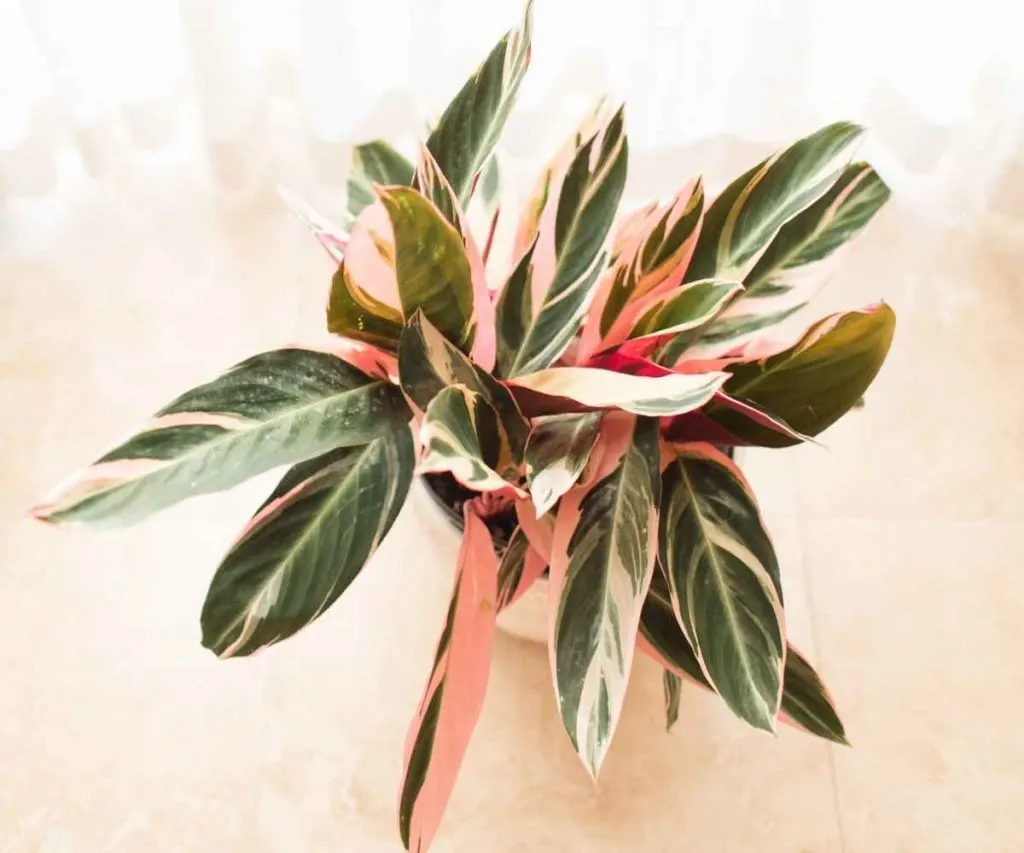
Triostar Size:
Triostar stromanthe grows to about 3 feet high and 2 feet in circumference at maturity. It makes a great patio plant in sub tropical climates.
Indoors you will eventually need a bit of space to show if off. This plant love bright indirect light. Find it an indirectly well lit nook and enjoy the show.
Common Stromanthe Problems:
Yellowing leaves and brown tips are common problems with all the prayer plants.
Our care guide is full of tips to help avoid watering problems. We also have tips on humidity and other care needs particular to the triostar.
You can also read our post on Seven Reasons your plant has yellowing leaves for even more help.
Triostar Care:
Stromanthe triostar care is similar to Calathea care needs and other prayer plants.
Below is our complete care guide with focused triostar tips. The triostar plant are a bit less sensitive than the fussier Calatheas.
But don’t ignore it.
Stromanthes are plant divas. They want attention.
Ignore their needs and reap brown tips, yellowing, and or dropping leaves.
It’s all in learning what they require and then tweaking your plant care to accommodate them.
Stromanthe Triostar Care Guide
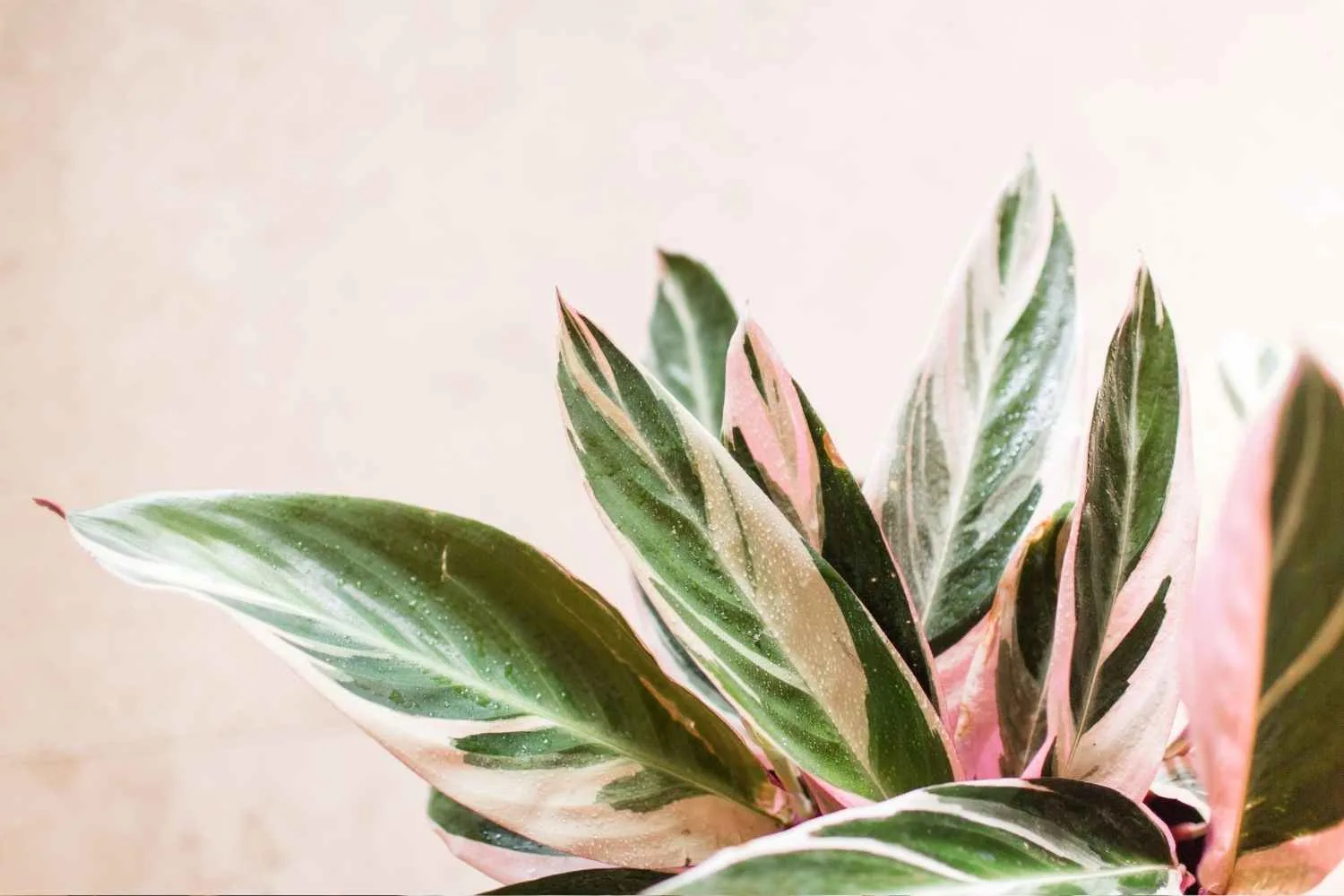
Stromanthe Triostar is a beautiful plant with eye catching three color variegated pattern in it's long narrow leaves. Triostar care needs are specific and important. They are sensitive. This is Not a forgiving plant.
Once you learn the perfect growing conditions for your triostar it will perform well for you. The stromanthe plants are in the prayer plant family. These are relatives or the maranta and Calathea plants.
Materials
Tools
Instructions
Soil Preference:
- These plants enjoy a light well draining soil.
- A mix of potting soil and perlite and peat will keep the roots happy if well mixed with lighter soils, perlite or pumice.
- Our mix for this plant is 30 % potting mix, 30% succulent soil or peat and 30% perlite or pumas.
- A heavy soil potting mix is not recommended for these plants.
Pot Size and Type
- Triostars grow from rhizomes. And they grow new offshoots to the sides of the mother plant.
- Stromanthes will grow to the size of the pot . However, They do not like to be overly root bound.
- If you want to encourage faster growth choose a pot about 2 inches wider in diameter than the current pot.
- Use a well drained ceramic or plastic pot. It MUST have excellent drainage.
- Repot every second year or when roots come out the drainage holes on the pot bottom To the next pot size up.
- Don't jump to a huge pot from a small one unless you wish to encourage faster growth. Just go to the next size up pot. A Too large pot with too much constantly moist soil will encourage root rot.
- A self watering pot system works well. (linked above). They control the watering for you and help avoid root rot, overwatering and under watering.
Lighting: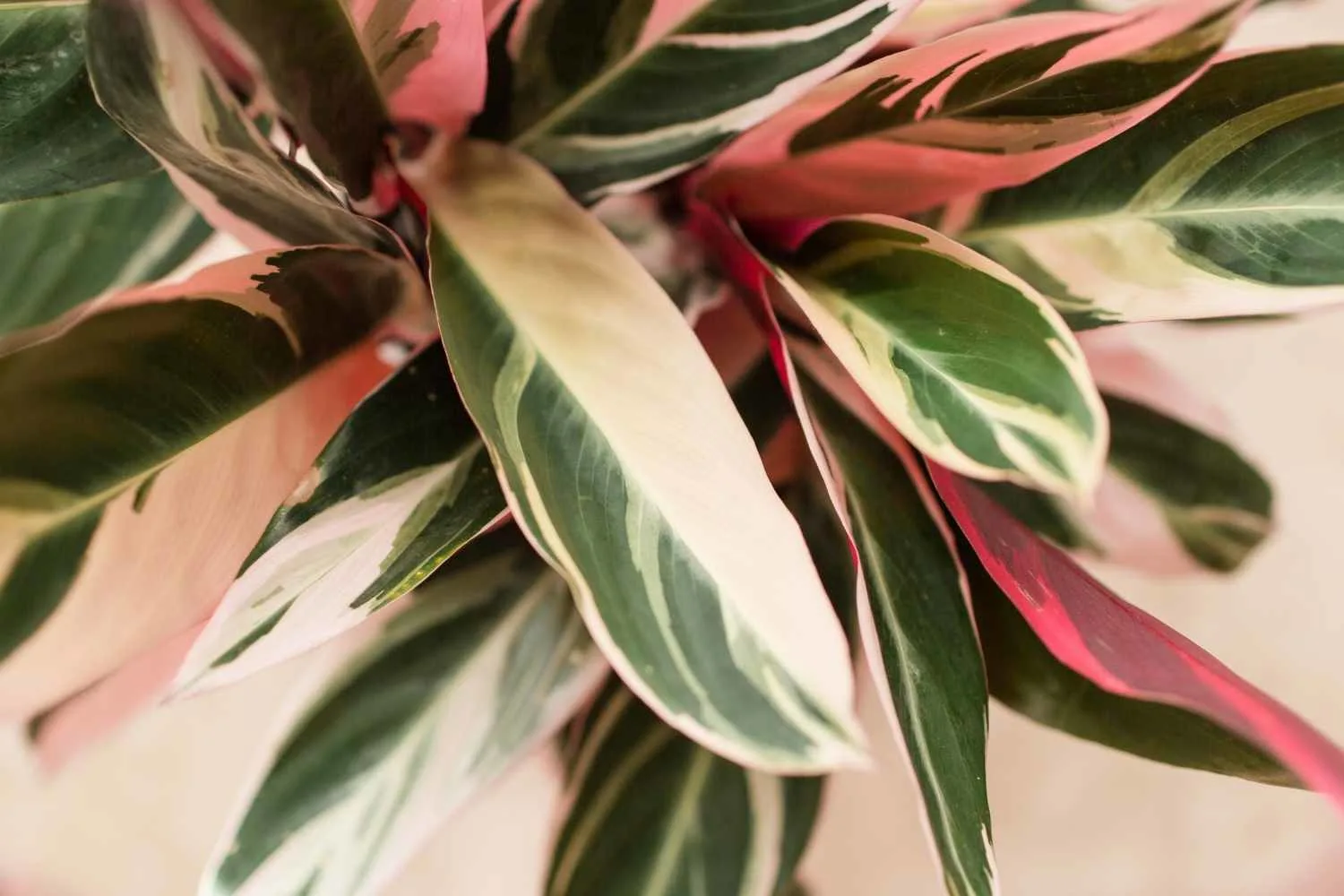
The Triostar enjoys bright indirect light for best leaf variegation and optimal growth.
- If the leaves fade move the plant to a brighter area and see if that helps.
- Too much light can also fade the leaves and crisp the leaf edge.
- It will tolerate lower indirect light but the plant may grow more slowly. Leaf variegations may also not be well expressed.
- Shield the plant from strong direct light in summer south and west sunny windows. The leaves will burn and the colors will fade. Look for dry brown spots on the leaves and curling brown edges. If you see them move the plant to lower light.
- Tip: Window sheers or blinds can offset some brief periods of high direct light.
Watering:
- Your stromanthe triostar is sensitive to the water you use. These plants love low mineral, soft acid water between 5.5 and 6 Ph. Hard water high in minerals and salts will burn the leaves.
- Collect rain water or use Filtered or distilled water to prevent problems with minerals and PH.
- Water when the soil is dry down an inch or so. Triostar enjoys even moisture in the soil. But never let it sit in soaking wet potting mix.
- Be sure to use your moisture meter every couple of days and especially before watering. The dial should read moist when pushed down to the bottom of the root system. If the meter reads almost dry you need to water. But if it reads wet WAIT. This is important. Triostar plants are sensitive and easily get yellowing leaves and root rot. Do not overwater!
Watering Problems:
- If Triostar leaves start to roll up and curl, the plant droops or the edges turn brown suspect watering problems.
- Under watering can show all the symptoms listed above and most often causes leaf edges rolling up, brown tips and crisping. Adjust your watering or soil mix to accommodate.
- Over watering will end in root rot, grey mold on the leaves and soil, algae growth on the soil and fungus gnats or other pests moving in. Yellowing leaves can also mean the plant roots are too saturated and are starting to die.
- For best practices Try a watering schedule of once a week. But do not water if the soil is wet. Alternately, Do not let the soil dry out completely.
- Watering is best done on a regular schedule with a moisture meter check so the plant is not over or under watered. Both can cause stress.
- These tropical plants enjoy humidity of 50 to 70%. Use a hygrometer next to your plants to make sure you have enough humidity for them.
- Never let this plant get wet feet. If the soil is compacted the bottom of the soil can remain wet which encourages, grey mold on the leaves, root rot and Fungus Gnats. If you see yellow leaves or leaf tips you are probably overwatering or Inconsistently watering.
In dormant winter months reduce watering to when the soil is dry down 2 inches .
Humidity Tips:
- Triostars love humidity. They are happy at 50 to 60% humidity. Although they can tolerate higher, do not let it drop under 40%.
- Low humidity results in brown crispy tips or edges.
- I use an inexpensive hygrometer to monitor the room temperature and humidity levels near mine. It is cheap and so helpful!
- In dry climates this plant will thrive with a humidifier nearby. Or set it in your kitchen or bathroom.
- Frequent misting on a regular daily schedule will help keep humidity up when all else fails. However, misted leaves can be hosting spots for bacteria and fungi.
- Set the plant on a pebble tray with water not touching the pot bottom for added humidity as necessary.
- Grouping plants together will also provide more humid conditions as they respire and evaporate.
- If triostar leaves show viral or bacterial spots on them your humidity may actually be too high. Try reducing it and keep an eye on the watering. This can also be a sign of unhealthy roots.
How to Fertilize Stromanthe:
- These prayer plants require a regular fertilizing schedule. BUT, they are susceptible to fertilizer burn.
- Apply a good quality fertilizer (linked in materials) monthly through Spring and summer at half dose. If you see burn marks on the plant leaves reduce fertilizer by half again.
- Decrease feedings by late Fall and allow your plant to rest through the winter months.
- Look for brown spots on the leaves of your troistar plants. This may indicate an over concentration of salts in the roots from over feeding. It can burn the leaves.
- The remedy is to flush water through the plant pot soil for several minutes. Allow the pot to Completely drain. Discontinue fertilizer until the plant recovers.
Temperature:
- Optimal temperatures for Stromanthe plants are 65 degrees F. to 80 degrees F. They will tolerate lower of higher of 55 to 85 for short periods.
- Prayer plants in general are sensitive to cold drafts from windows and doors.
- In winter, beware heat vents blowing on your plant leaves. Uneven heating, drying heat vents and drafts should be avoided.
Pruning and Training:
- Sharp sterile Hand pruners or sharp scissors are preferred for pruning. They will give a clean cut that will heal quickly.
- Pruning is usually done to shape the plant or cut off unsightly leaves.
How Big Will the Stromanthe Triostar Get?
Stromanthe grows wider rather than taller with time. The triostar plant grows to about 36 inches high at maturity. They will spread up to 24 inches.
Leaf Care:
- For the best care triostar leaves enjoy occasional washing.
- This helps keep the stomata (leaf pores) open for plant respiration.
- Healthy leaves with a good clean surface are most able to resist pests. Neem oil leaf shine and water is a good choice for leaf washing.
- Dusty leaves will starve the plants of water exchange through humidity.
- washing your plant leaves is also a great way to keep pests off the leaves. And early pest intervention since you are closely examining your plant.
- Hand Wash the leaves monthly with water and neem oil.
- If you notice an occasional yellow leaf that droops and fall off the plant this is normal but keep an eye on it. Check for pests, watering issues and how your feeding your plan as you care for the leavest.
- Read our post on 7 reason why your plant has yellow leaves for more trouble shooting tips.
Pests:
- Stress by longterm poor watering practices, poor light, extreme temperatures and soil conditions are contributors to pests. Fungus gnats will set up house in the soggy soil of an overwatered plant.
- Washing the plant leaves occasionally with neem oil leaf shine will help keep pests from establishing themselves on the plant.
- Spider mites easily set up house on prayer plants. Watch for the webs. Treat immediately and continue for two weeks or more to remove the next generation of spider mites after the adults die. Eggs attach to the leaves and cannot be washed off easily.
- Mealy bugs, scale, thrips and whitefly are also common houseplant pests you will see in many houseplants.
- Read our post on How to get rid of aphids and other pests with our homemade pesticide soap recipe or neems oil.
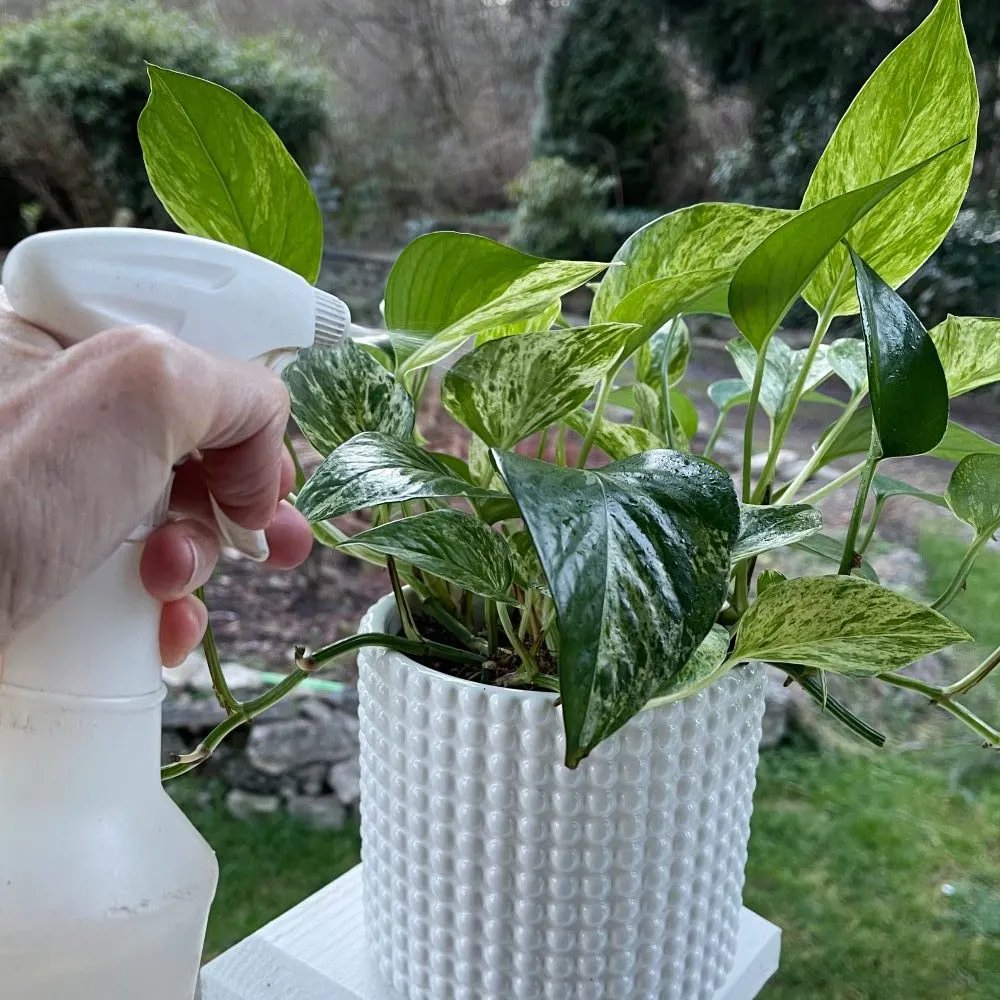
- To minimize the possibility of pests be sure to check all nursery plants before bringing them home. Carefully examine the top and bottom of the leaves.
- Do NOT purchase plants with signs of pest damage or disease.
- Quarantine all new plants until you are sure no pests live in them.
How to Propagate Stromanthe:
- Propagation is best done through root division.
- Dividing a triostar is easiest when repotting it in spring or summer.
- Unpot the plant gently. Look at the root system. If the plant is mature you should see a natural parting in the leaves and roots. This is the two plants growing together.
- Each plant section will have its own rhizome. This is going to look like the stem growing straight down with roots coming off them.
- Gently pull apart the two rhizomes to separate them. If the roots are heavily intertwined cut them as necessary with sharp sterile scissors or small pruners.
Pot the two plant sections in separate pots. In 2 to 4 weeks the divisions should be settled and growing.
Non Toxic Plant:
- Triostars are non toxic to humans and pets. Still it is not recommended to chew any houseplant.
- Biting or swatting are not good for the health of the plant.
- Also you don't know what chemicals, pests or pathogens are in the soil or fertilizers you use. So best practice is to keep houseplants away from pets and kids.
Notes
The video below is relevant to the care of all prayer plants:
Related Content:
Follow Us:
Find us on YouTube, Instagram , Pinterest and TikTok! We love to Plant chat. We also comment, like and occasionally share your content to our daily stories. We’d love to see your plants. Share your joy in your houseplants. Happy Planting!
Recent Posts:
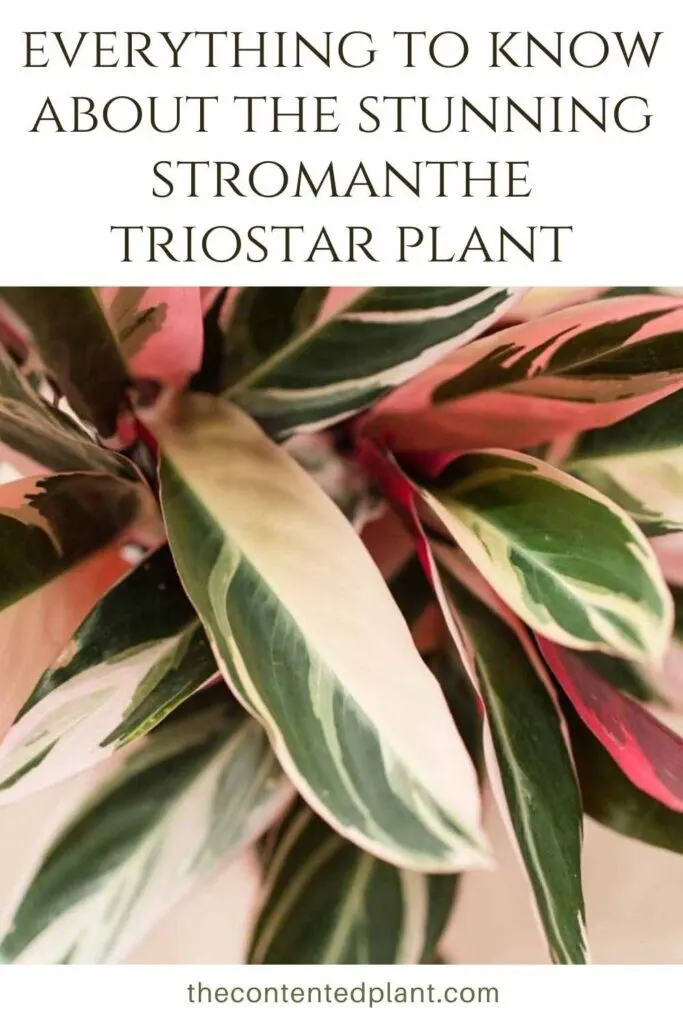


Variegated Burle Marx Plant Care Guide and Profile - The Contented Plant
Saturday 11th of December 2021
[…] Stromanthe Triostar […]